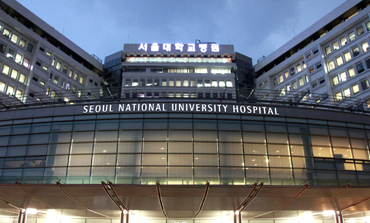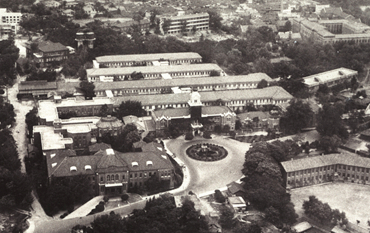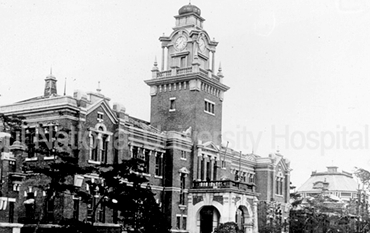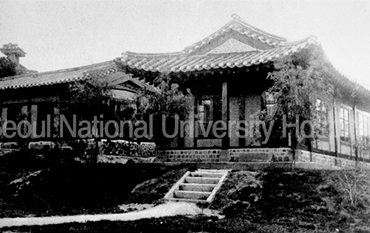1978 ~ Present
SNUH Foundation expandsSouth Korean medical service worldwide




In 1978, the Hospital Affiliated with the College of Medicine of SNU was reorganized into SNUH Foundation, a special corporation, to raise medical service in South Korea to world-class levels by maximizing its autonomy and efficiency. Article 1 of the Establishment of Seoul National University Hospital Act, legislated at this time, reads, "The purpose [of the present Act] lies in promoting the development of medicine and contributing to the improvement of the national public health by establishing Seoul National University Hospital and providing education, research, examination, and treatment in medicine and dentistry." This signifies that SNUH has been officially and legally recognized as the center of national medical service.
At the same time as corporatization, the new hospital building, a long-cherished dream of SNUH, was finally completed. With 1 floor underground and 13 floors aboveground and hospitalization and examination facilities including 1,056 beds and a capacity for over 2,000 outpatients, it was the largest hospital in Northeast Asia at the time. SNUH thus consolidated its basis as the representative hospital of South Korea and for its role as the hub of medical research.
Since then, SNUH has pioneered medical service in South Korea by launching the first Children's Hospital nationwide, operating Seoul Metropolitan Government-SNU Boramae Medical Center on consignment, and establishing SNU Bundang Hospital and SNU Hospital (Health Care System) Gangnam Center. As for medicine and medical practice, it succeeded in the birth of a test tube baby and partial and whole liver transplants, all unprecedented in the country. Furthermore, it has succeeded in separating the hepatitis C virus serum and developing a new liver cancer test method, both for the first time around the globe. In addition, it has developed the first artificial pancreas in South Korea and the smallest artificial heart worldwide, obtaining an American patent. In terms of medical research, the medical staff at SNU College of Medicine and SNUH published 1,065 papers in academic journals registered in the Science Citation Index (SCI) in 2005 alone, which was the first time for a single medical institution across the nation to publish over 1,000 papers, thus demonstrating at home and abroad that they had the capability to lead the era of internationalized medical service. In addition, SNUH formed the Public Health Medical Services in 2006 and has engaged in medical volunteer service for medically underprivileged groups domestically and internationally.
In conclusion, SNUH not only faithfully plays a role that becomes its prestige as the national central hospital of South Korea but also is leading medical service in the country to a world-class level.
In 1946, a year after the Liberation, SNU was established. At the time, the Medical School of the former Gyeongseong Imperial University and the former Gyeongseong Medical College were combined to launch the SNU College of Medicine, and the Hospital Affiliated with the Medical School of the former Gyeongseong Imperial University became the Affiliated Hospital of the College of Medicine of SNU.
Amidst the political and ideological maelstrom immediately following the Liberation, the SNU College of Medicine and its affiliated hospital devoted their energy to research, education, examination, and treatment. During the Korean War (1950-53), they continued medical education by operating the Wartime United University in Busan and did their utmost to examine and treat local residents and refugees by operating relief hospitals on Jeju Island and in Busan. During 1954-61, they repaired the facilities through the Minnesota Project and introduced the latest medicine and medical education methodology through the faculty members' training in the United States. As a result, departments including the Department of Thoracic and Cardiovascular Surgery, Department of Neurosurgery, Department of Anesthesiology, and Department of Clinical Pathology came to secure the bases for development, and the internship/residency system was established. The hospital succeeded in the first open-heart surgery using a cardiopulmonary bypass (CPB) nationwide in 1963 and succeeded in the first separation of the hepatitis B virus antigen worldwide and developed and commercialized a vaccine during the 1970's.
In the end, despite and amidst adverse social conditions including national division into North and South Koreas, war, and economic hardships, the Hospital Affiliated with the College of Medicine of SNU led medicine and medical service in South Korea, thus contributing to the national life and social development through the healing art. In particular, it fulfilled its mission as the national central hospital by faithfully playing the role of the central base of the introduction and dissemination of advanced medicine and fostering numerous medical scientists through systematic training, thus allowing them to become the medical staff at medical schools across the country.
Executed in 1910, the annexation of Korea by Japan spelled immense disaster for the entire nation in all fields including politics, economy, society, and culture. Nor could the field of medical service be an exception. Due to Japanese occupation, the movement to establish the basis of modern medicine with our own hands came to be frustrated. Immediately after the annexation of Korea by Japan, Daehan Hospital was reorganized into Jung'ang Hospital, then into the Government-General of Korea (GGK) Hospital. The Medical School Affiliated with Daehan Hospital likewise was reorganized as the Medical Training School Affiliated with the GGK Hospital. All fields constituting hospitals and medical education including operation, organization, and human power were changed into a system focused on the Japanese. Except for a minority of ethnic Koreans, major staff members of hospitals and schools including hospital directors, physicians, professors, druggists, assistants, administrative officers, and interpreters therefore came to be replaced by the Japanese.
With the proclamation of the Ordinance on Professional Schools in 1916, the Medical Training School Affiliated with the GGK Hospital was promoted as the Gyeongseong Medical College. The director of the GGK Hospital served also as the dean and the medical officers and physicians from the same institution served also as professors, and the GGK Hospital came to function as the internship hospital for Gyeongseong Medical College. Following the launching of the Medical School of Gyeongseong Imperial University in 1926, the GGK Hospital was reorganized into the Hospital Affiliated with the Medical School of Gyeongseong Imperial University in 1928, and Gyeongseong Medical College established its own affiliated hospital separately in Sogyeok-dong, Jongno-gu, Seoul. Although the number of ethnic Korean physicians and medical scientists increased somewhat, all duties continued to be performed under Japanese supervision so that it was nearly impossible for ethnic Koreans to become physicians at the affiliated hospitals or professors at the schools. Notwithstanding such adverse environments and conditions, the ethnic Korean medical school students and physicians at the Medical School of Gyeongseong Imperial University, Gyeongseong Medical College, and the two affiliated hospitals diligently studied advanced medicine and grew into capable medical specialists and went on to lead South Korean medicine following the Liberation (1945).
Following the opening of the country's doors to the world in 1876, King (later Emperor) Gojong (1852-1919; r. 1863-1907) and the government of the Joseon Dynasty (1392-1910) established and set out to implement a modernization project on a national scale. Here, they focused also on the modernization of medicine. Consequently, through an inspection party dispatched to Japan in 1881, they explored Western medicine and, through the Hanseong Sunbo, the government bulletin, in 1884, informed the people of the need for Western medical education. When Robert S. Maclay, an American Methodist missionary, entered Korea and suggested the foundation of a Western-style hospital, he was granted royal permission. Then, in 1884, Gapsin Coup was executed. In the course of events, Horace N. Allen, an American physician-missionary, saved the life of Yeong-ik Min, a high-ranking government official who had been stabbed by an assassin. The even served as a catalyst to the opening of a Western-style national hospital.
Finally, in April 1885, King Gojong and the Joseon government established Jejung Hospital ("House of Universal Helpfulness") under the Board for General Control of Diplomatic and Commercial Matters (equivalent of the present-day Ministry of Foreign Affairs and Trade (MOFAT)). They provided the land, buildings, facilities, administrative workers, and operating expenses and employed American physicians to examine and treat patients. Of course, the overall management and supervision of Jejung Hospital were the province of government officials. Consequently, missionaries at the time likewise alluded to Jejung Hospital in diverse reports as the "government hospital." In the end, Jejung Hospital became the first Western-style national hospital to be established and operated by the Joseon government in Korea.
King Gojong and the Joseon government assigned two special missions to Jejung Hospital, which was the national hospital. The first consisted of teaching Western medicine to intelligent young men so that they would become competent medical specialists. The second consisted of treating impoverished patients free of charge. Already at the time of Jejung Hospital, the advancement of medicine and public medical service were established as the social responsibility of the national hospital.
Even after the establishment of the Empire of Korea in 1897, the Korean government continued to maintain the basic goals of the nation's public health and medical service policy as the advancement of medicine and the provision of public medical service. In 1899, it founded Gyeongseong Medical School (predecessor of the present-day SNU College of Medicine), a public institution, to foster physicians, and opened Gwangje Hospital ("House of Extended Helpfulness") as the new national hospital, devoting its energy to the examination and treatment of indigent patients and the spread of inoculation.
In 1907, the Empire of Korea established Daehan Hospital by combining Gyeongseong Medical School, its affiliated hospital, Gwangje Hospital, and the Korean Red Cross Hospital, which was under the royal household. A comprehensive medical institution providing education, research, examination, and treatment, Daehan Hospital also played the role of a public medical institution. Furthermore, it even had the authority to oversee the country's medical service and public health projects. With the annexation of the Empire of Korea by Japan in 1910, the project to modernize medicine in Korea was frustrated for the time being. Nevertheless, the experience of modernizing medicine that continued from Jejung Hospital to Daehan Hospital had a considerable effect on the history of medical service in Korea.